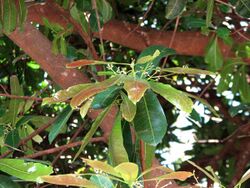Biology:Buchanania arborescens
| Buchanania arborescens | |
|---|---|

| |
| Scientific classification | |
| Kingdom: | Plantae |
| Clade: | Tracheophytes |
| Clade: | Angiosperms |
| Clade: | Eudicots |
| Clade: | Rosids |
| Order: | Sapindales |
| Family: | Anacardiaceae |
| Genus: | Buchanania |
| Species: | B. arborescens
|
| Binomial name | |
| Buchanania arborescens (Blume) Blume[2]
| |
| Synonyms | |
|
List
| |
Buchanania arborescens, commonly known as the little gooseberry tree[3] or sparrow's mango,[1] is a small and slender tree native to seasonal tropical forests of northern Australia , Southeast Asia, and the Solomon Islands.
The leaves are spirally arranged, smooth, leathery, elongated oblong, 5–26 cm long. The flowers are very small cream to yellowish white. The edible fruit are globular, small (1 cm long), reddish to purple-black. Torresian imperial pigeons and other birds eat these.[3]
The species was formally described in 1826 by botanist Carl Ludwig Blume based on plant specimens collected from Java. Initially naming it Coniogeton arborescens, Blume transferred the species to the genus Buchanania in 1850.[4]
In Australia the species occurs naturally across the northern extremities of the continent from Western Australia and across the Northern Territory to Queensland where it extends down the east coast as far south as Hinchinbrook Island.[3][5]
Uses
Aboriginal people eat the fruit raw. The plant is also used as a traditional medicine in Australia and Malaysia.[6] The 1889 book 'The Useful Native Plants of Australia' records that "The unripe fruits of this plant were gathered, and, when boiled, imparted an agreeable acidity to the water, and when thus prepared, tasted tolerably well. When ripe, they become sweet and pulpy, like gooseberries, although their rind is not very thick. This resemblance induced us to call the tree 'the little gooseberry'tree" quoted from Leichhardt: Overland journey to Port Essington, p. 479.[7]
In culture
The tree is called balingasay in Tagalog, and in pre-colonial times were regarded as domains (dambana) of Lakan Balingasay, the anito of the tree and probably of insects (due to comparisons with Beelzebub in accounts by friars).[citation needed]
References
- ↑ 1.0 1.1 Ganesan, S. (2021). "Buchanania arborescens". IUCN Red List of Threatened Species 2021: e.T61983514A61983516. https://www.iucnredlist.org/species/61983514/61983516. Retrieved 22 December 2023.
- ↑ "Buchanania arborescens (Blume) Blume". Australian Plant Name Index (APNI), IBIS database. Centre for Plant Biodiversity Research, Australian Government. http://www.anbg.gov.au/cgi-bin/apni?taxon_id=14311.
- ↑ 3.0 3.1 3.2 "Buchanania arborescens". Centre for Australian National Biodiversity Research (CANBR), Australian Government. 2020. https://apps.lucidcentral.org/rainforest/text/entities/Buchanania_arborescens.htm.
- ↑ "Buchanania arborescens (Blume) Blume". Flora of Australia Online. Department of the Environment and Heritage, Australian Government. http://www.anbg.gov.au/abrs/online-resources/flora/stddisplay.xsql?pnid=48913.
- ↑ "Buchanania arborescens (Blume) Blume". FloraBase. Western Australian Government Department of Parks and Wildlife. https://florabase.dpaw.wa.gov.au/browse/profile/9061.
- ↑ Brock, J., Top End Native Plants, 1988. ISBN:0-7316-0859-3
- ↑ J. H. Maiden (1889). The useful native plants of Australia : Including Tasmania. Turner and Henderson, Sydney. https://primo-slnsw.hosted.exlibrisgroup.com/primo-explore/fulldisplay?docid=SLNSW_ALMA21105097830002626&context=L&vid=SLNSW&search_scope=EEA&tab=default_tab&lang=en_US.
External links
- "Buchanania arborescens (Blume) Blume". Atlas of Living Australia. https://bie.ala.org.au/species/http://id.biodiversity.org.au/node/apni/2897989.
Wikidata ☰ Q4982610 entry
 |


